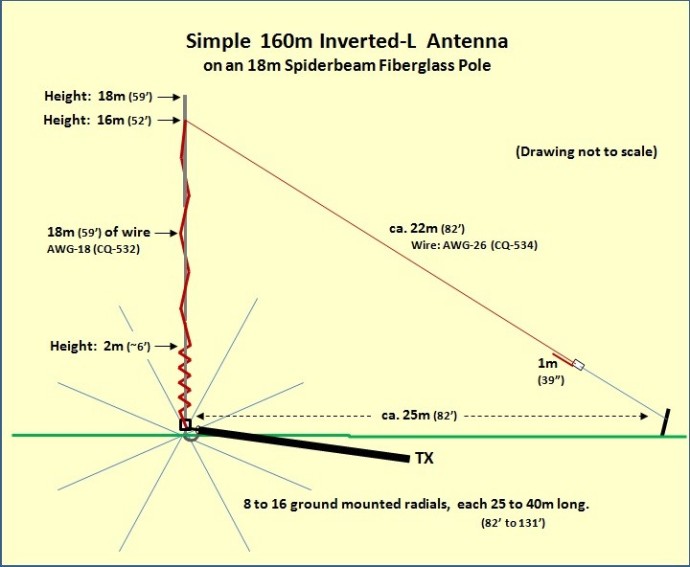160m INVERTED-L / 18m Spiderpole
For those who cannot install a 132 ft. high Vertical. :-)
CAUTION: INVERTED-L ANTENNAS USING TOP-HAT WIRES
CAN HAVE LETHAL HIGH VOLTAGE NEAR THE ENDS OF THE WIRES.
KEEP OUT OF REACH OF HUMANS AND ANIMALS !!!
Most People's Thinking is WRONG:
Most people believe an Inverted-L must be a perfectly straight vertical segment,
bent 90 degrees, and then run perfectly horizontal for the rest of its length.
GOOD IDEA; BUT NOT NECESSARY.
The reality is, almost anything near this configuration will work.
Some configurations work better than others.
It will still work very good, even if the horizontal wire has to be sloped diagonally to the ground (see picture below), as long as you have enough horizontal space to keep it at about a 45 degree angle or more from the pole.
(Shown here with ground radials but one or two elevated radials work even better.)
Comments
Shown here is an Inverted-L with its long leg sloping to the ground.
Of course you must keep the end of the antenna high enough above ground, such that humans and animals will not be harmed by the high voltage on the end of the wire.
If you can find a tree, house, pole, anything elevated which can be used to support the end, that will work better than when sloping to the ground.
As you raise the end, you will need to shorten the length of the long leg slightly.
Although the Inverted-L works better when the horizontal leg is horizontal and not diagonal, it will still work quite well, even if it is sloping to the ground.
MATCHING
The actual feedpoint impedance will depend on the ground characteristics at your location, and on the quality of your radial network.
If you have a good radial network, you may find that impedance of the antenna is very low and needs to be matched. The easiest way to do this is with a HAIRPIN MATCH.
It is always a good idea to feed Vertical and Inverted-L antennas through a Common Mode Current Choke.
SPECIAL GUYING INSTRUCTIONS:
In addition to the standard guying procedures for the 18m pole, you should also guy the pole at the point the diagonal wire exits the pole, using two ropes opposite the direction of the top wire, and spaced about 120 degrees apart. Together with the diagonal wire, these two ropes form a third level of guying for the pole.
Download standard guying procedures below.
DOWNLOADS
This document shows several of the details for building this antenna.
Spiderbeam inverted L instructions V.1.5[...]
PDF-Dokument [314.7 KB]
This document shows the standard instructions for guying the 18m fiberglass Spiderpole. These instructions do not include the special guying required near the top when mounting the 160m Inv.-L to this pole.
Guying the 18m Pole.pdf
PDF-Dokument [173.2 KB]


























